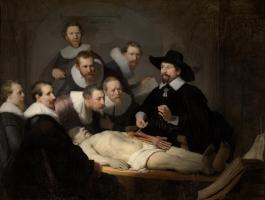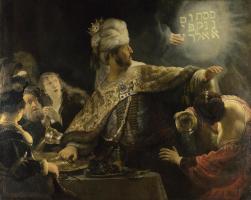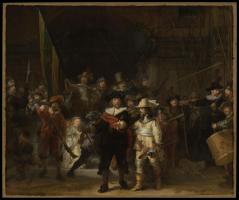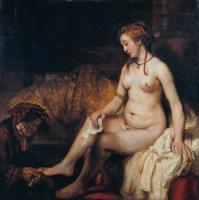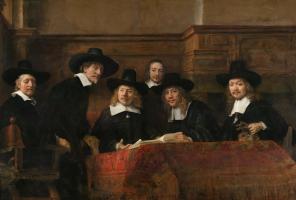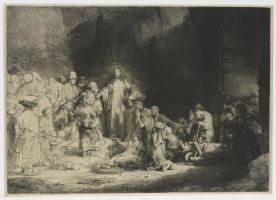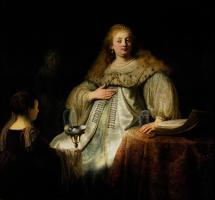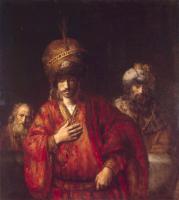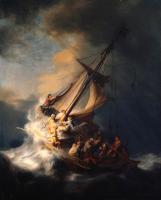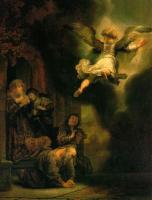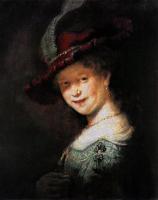Rembrandt
Rembrandt ranks with the greatest artists of all time, outstandingly gifted as a painter, a draughtsman and a print-maker. He was born in Leyden, Holland, the son of a miller, and trained in Amsterdam. Holland at the time of Rembrandt had recently emerged from the yoke of Spanish occupation, and the Golden Age of Dutch painting reflected this new-found freedom. It had become a major sea-power and its people were commercially successful and eager for celebrations of the good life. Hundreds of artists were drawn to its cities and made good livings.
In 1632 Rembrandt set up in Amsterdam as a portrait painter, and made his name with a group portrait of the Amsterdam Guild of Surgeons. He soon acquired scores of pupils and followers (at least fifty pupils are known by name). Once established, he refused to specialize, and his subject matter is immensely varied. But he never strayed far from his central concern : human beings, their spiritual aspirations and worldly realities. He produced no sea paintings, but there are landscapes, group portraits, religious, mythological and still life pictures, scenes of contemporary life and domestic scenes. He exploited to the full the effects of chiaroscuro , and has been called the most dramatic painter in history.
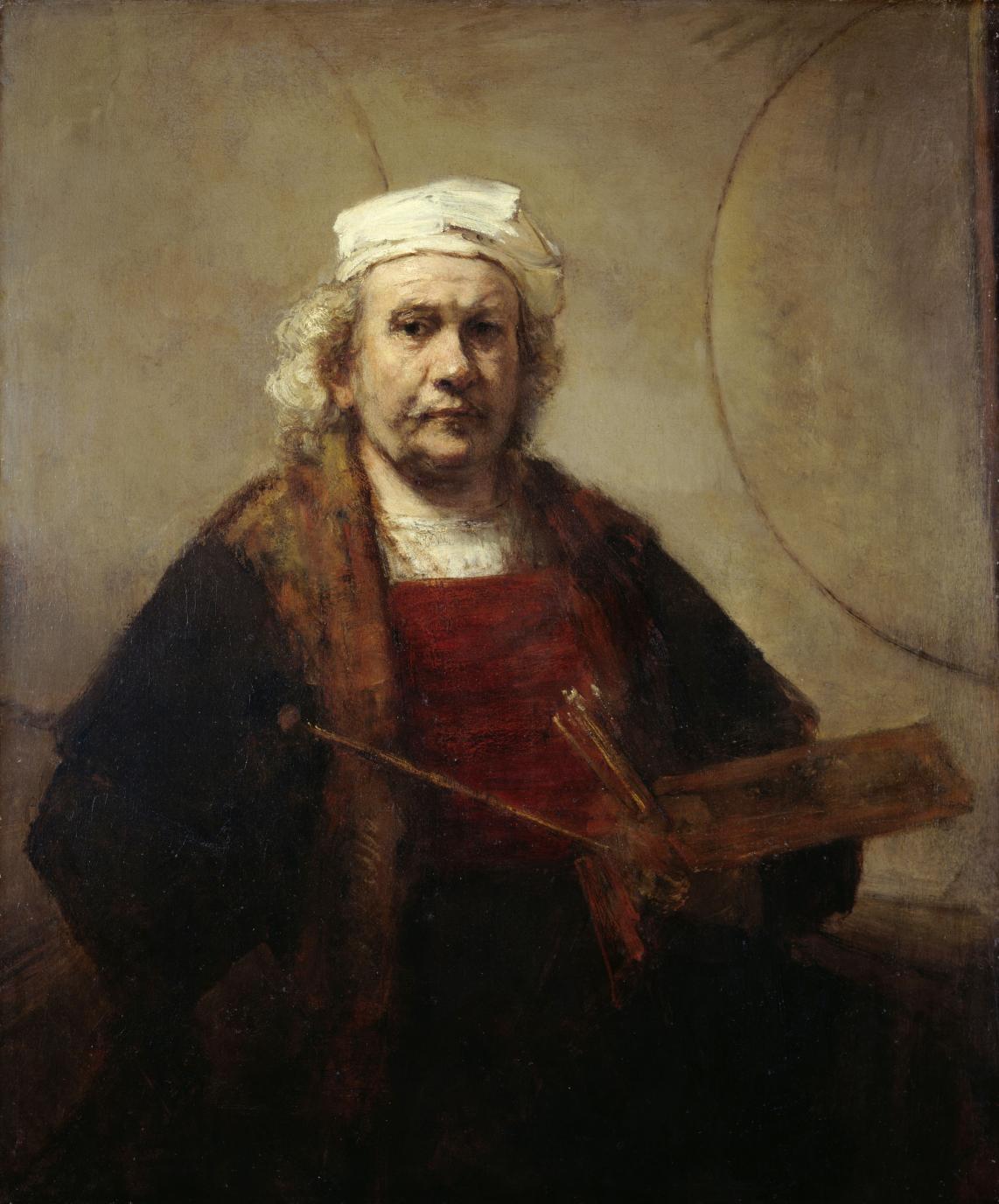 Rembrandt produced a long series of self-portraits, which reveal every stage of
his life and career in an ever-deepening analysis. One of his first recorded
paintings contains a portrait of himself, and something like a hundred
self-portraits, both drawings and paintings, have survived. As a result of
living well beyond his means, he was bankrupted in 1656, but he kept a mirror
from the creditors so that he could continue to paint himself. In some of the
portraits he appears with a confident air in fancy dress, acting the part of a
swaggering young man, a romantic, or a man of substance and responsibility. But
later in his life he reveals increasingly his disillusionment, suffering,
doubts and need for reassurance. Taken together, the self-portraits are the
finest, broadest and most moving visual autobiography ever created.
Rembrandt produced a long series of self-portraits, which reveal every stage of
his life and career in an ever-deepening analysis. One of his first recorded
paintings contains a portrait of himself, and something like a hundred
self-portraits, both drawings and paintings, have survived. As a result of
living well beyond his means, he was bankrupted in 1656, but he kept a mirror
from the creditors so that he could continue to paint himself. In some of the
portraits he appears with a confident air in fancy dress, acting the part of a
swaggering young man, a romantic, or a man of substance and responsibility. But
later in his life he reveals increasingly his disillusionment, suffering,
doubts and need for reassurance. Taken together, the self-portraits are the
finest, broadest and most moving visual autobiography ever created.
This one was painted near the end of his life, and is probably the most famous. He is in working clothes, with a white cloth round his head, and a thick warm coat to keep the cold at bay in the studio. The sombre colours show the typical Rembrandt palette of browns and black, contrasted with flesh tones and touches of white.
He holds his palette, a handful of brushes and a maulstick, a rigid slender rod used by painters to keep hand and brush steady when carrying out detailed work. The slant of the shoulders and spreading arms creates a wide pyramid shape, which gives the figure a solid, rock-like quality. The face is heavily furrowed, the skin patchy, and the bulbous nose is shown with no attempt at disguising its prominence. The expression in the mouth and eyes shows a lifetime’s experience. It is a remarkably self-penetrating study which reveals his sensitivity and imagination as a man and as an artist. Through capturing an outward appearance accurately and completely, Rembrandt exposes the inner landscape of the human character, and it is this understanding of humanity and his skill in portraying it that sets his art so high.
 Arguably the most well known among his works, The Night Watch is one of the
most famous Dutch Golden Age paintings.
Arguably the most well known among his works, The Night Watch is one of the
most famous Dutch Golden Age paintings.
The painting is famous for three things:
- its colossal size (363 by 437 centimetres (12 by 14+1⁄2 feet)),
- the dramatic use of light and shadow (tenebrism), and
- the perception of motion in what would have traditionally been a static military group portrait.
The painting was completed in 1642, at the peak of the Dutch Golden Age. It depicts the eponymous company moving out, led by their Captain (dressed in black, with a red sash) and his lieutenant (dressed in yellow, with a white sash). With effective use of sunlight and shade, Rembrandt leads the eye to the three most important characters among the crowd: the two men in the centre (from whom the painting gets its original title), and the woman in the centre-left background carrying a chicken. Behind them, the company’s colours are carried by the ensign. The figures are almost life-size.
 The Archangel Raphael helps Tobias to restore his father’s sight and then flies
off in a Baroque flurry of foreshortened limbs, wings and drapery. But most
impressive of all is Rembrandt’s masterful chiaroscuro.
The Archangel Raphael helps Tobias to restore his father’s sight and then flies
off in a Baroque flurry of foreshortened limbs, wings and drapery. But most
impressive of all is Rembrandt’s masterful chiaroscuro.


